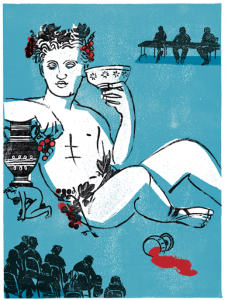I am perhaps more invested in grammar and mechanics than other writing teachers, often much to my students’ chagrin. As you will quickly learn, I have strong feelings about overuse of the semicolon in writing. As Kurt Vonnegut famously said,
Here is a lesson in creative writing. First rule: Do not use semicolons. They are transvestite hermaphrodites representing absolutely nothing. All they do is show you’ve been to college.
That said, semicolons can and do accomplish a certain amount of conceptual work, especially in the kinds of evidence-laden writing that we will be working on this year in HumCore. As Abraham Lincoln apparently said, the semicolon can be “a useful little chap.” Ben Dolnick wrote a great short piece for The New York Times Opinionator blog about his semicolon “love story”. He writes,
The semicolon sat there in my literary utensil drawer like a cherry pitter, theoretically functional, but fussy and unloved and probably destined for the yard-sale table. So it’s been with considerable surprise, these past few years, that I’ve found myself becoming something of a cherry-pitting maniac. This may just, as Vonnegut says, reflect the fact that I’ve now been to college, though honestly I can’t remember anyone’s expressing a single semicolon-related sentiment while I was there. Regardless, I’ve come to love the awkward things, and to depend on them for easing me through a complex thought.
The New Yorker has begun making wonderful short videos about grammar and mechanics starring Mary Norris, a longtime query proofreader at the magazine. If you need a quick and dirty review of how the semicolon works (both as what Norris calls an “industrial-strength comma” and as a hinge between two independent clauses), watch her video here. She also has a great breakdown of when to follow the old rule of never ending a sentence in a preposition.
My beloved Purdue OWL also has great grammar, mechanics, and punctuation guides that are broken down by topic, so if you have a particular, nagging problem in your writing — or, if you find I am constantly writing “dangling modifier!” or “comma use!” on your papers — you can directly target specific issues with their help.




